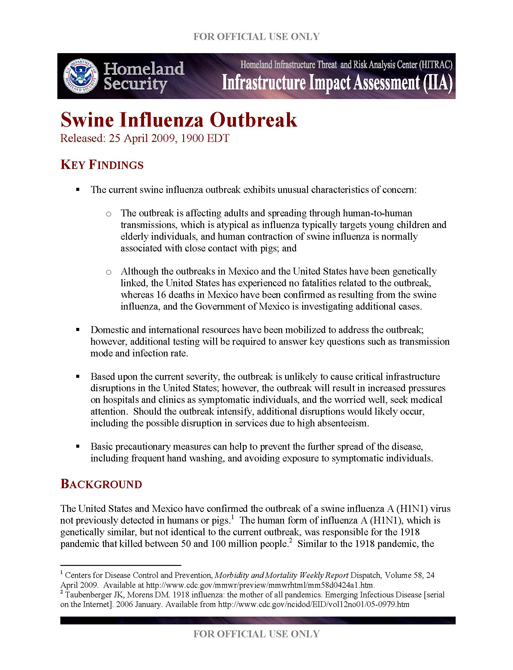 Homeland Infrastructure Threat and Risk Analysis Center
Homeland Infrastructure Threat and Risk Analysis Center
- Infrastructure Impact Assessment
- 5 pages
- For Official Use Only
- April 25, 2009
The current swine influenza outbreak exhibits unusual characteristics of concern:
- The outbreak is affecting adults and spreading through human-to-human transmissions, which is atypical as influenza typically targets young children and elderly individuals, and human contraction of swine influenza is normally associated with close contact with pigs; and
- Although the outbreaks in Mexico and the United States have been genetically linked, the United States has experienced no fatalities related to the outbreak, whereas 16 deaths in Mexico have been confirmed as resulting from the swine influenza, and the Government of Mexico is investigating additional cases.
- Domestic and international resources have been mobilized to address the outbreak; however, additional testing will be required to answer key questions such as transmission mode and infection rate.
- Based upon the current severity, the outbreak is unlikely to cause critical infrastructure disruptions in the United States; however, the outbreak will result in increased pressures on hospitals and clinics as symptomatic individuals, and the worried well, seek medical attention. Should the outbreak intensify, additional disruptions would likely occur, including the possible disruption in services due to high absenteeism.
- Basic precautionary measures can help to prevent the further spread of the disease, including frequent hand washing, and avoiding exposure to symptomatic individuals.
BACKGROUND
The United States and Mexico have confirmed the outbreak of a swine influenza A (H1N1) virus not previously detected in humans or pigs. The human form of influenza A (H1N1), which is genetically similar, but not identical to the current outbreak, was responsible for the 1918 pandemic that killed between 50 and 100 million people. Similar to the 1918 pandemic, the current outbreak is affecting adults, whereas influenza typically affects young, elderly, or immune-compromised individuals.
United States Overview
The U.S. Centers for Disease Control and Prevention (CDC) confirmed six swine influenza cases in California located in San Diego and
Imperial Counties, and two cases in Texas in Guadalupe County (near San Antonio). An additional two cases have been confirmed in Kansas, and testing is currently underway at Saint Francis Preparatory School in Queens, New York, where students who had recently returned from a trip to Mexico began exhibiting influenza-like symptoms. Results from a New York Laboratory
indicated that eight of the cases tested were positive for H1N1. Samples have been sent to the CDC for confirmation.5 Increased attention to the outbreak is likely to lead to the identification of additional cases as public health professionals increase testing, and symptomatic individuals seek medical care.All of the confirmed cases in the United States have fully recovered to date, although one immuno-compromised woman in California was hospitalized. None of the confirmed cases in the United States had direct exposure to pigs indicating the disease is spreading from human-tohuman.
Mexico OverviewThe Government of Mexico has confirmed 18 deaths from the swine influenza mostly in Mexico City; however, media reports indicate over 1,000 cases of influenza in Mexico. Testing is underway to identify which of these cases resulted from the swine influenza, and which resulted from other influenza strains, or co-infection (infection resulting from more than one virus).
Mexico’s surge in influenza cases began in mid-March towards the end of Mexico’s flu season. Mexican officials have closed schools, museums, libraries, and other public buildings, and suspended public events in an effort to curb the spread of the disease. Masks have been distributed, and citizens urged to avoid social activities. The Government of Mexico’s vaccination effort is focused on health workers due to their higher risk of contracting the disease. Efforts are also underway to question outbound travelers to help stem the spread of the disease.Swine Influenza
Swine influenza is common among pig populations in the United States, and leads to a high rate of illness, but low mortality rates. Symptoms in pigs include sudden onset of fever, depression, coughing (barking), discharge from the nose or eyes, sneezing, breathing difficulties, eye redness or inflammation, and going off feed. Outbreaks in pig populations typically occur in late fall and winter. The infection rate for humans contracting the disease is typically low, and accompanied by close contact with swine. The current cases do not follow this pattern.

